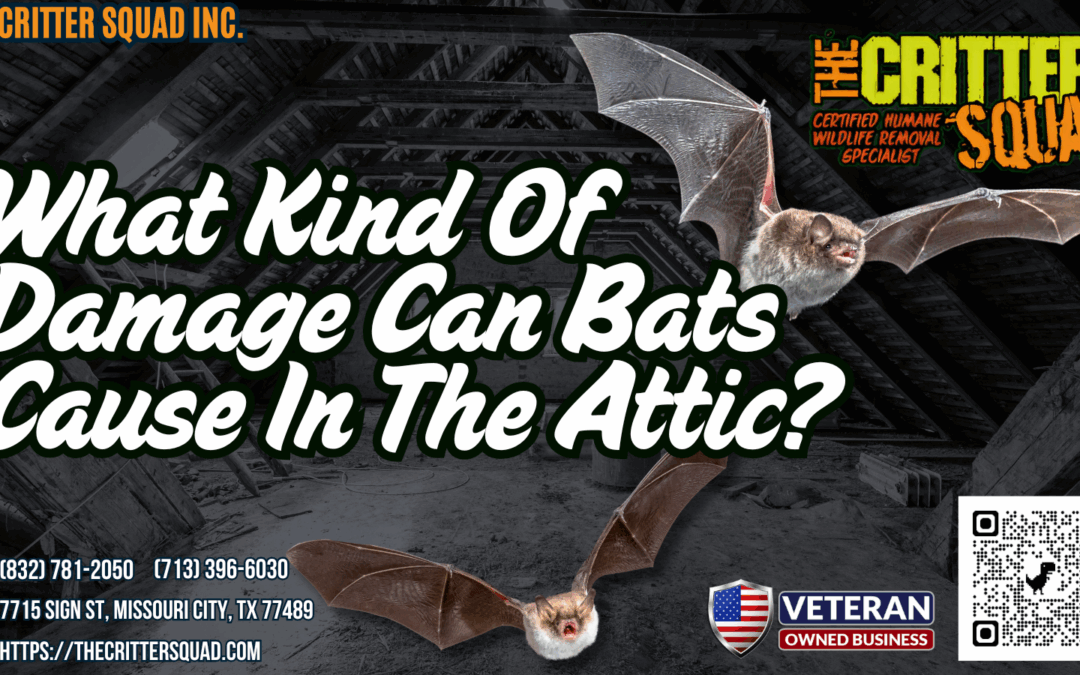Bats can inflict various types of damage within attics. They compromise structural integrity by nesting and depositing guano, which erodes wood and promotes mold growth. Insulation becomes contaminated and less effective, often requiring replacement. Bats also pose risks to electrical systems and HVAC efficiency through droppings that corrode wiring and disrupt airflow. The presence of guano leads to health concerns, attracting pests and causing unpleasant odors. Understanding these impacts reveals deeper implications for homeowners facing bat infestations.
Key Article Highlights
- Bats can cause structural damage by eroding wood and weakening beams through guano accumulation and moisture.
- Their droppings contaminate insulation, leading to decreased effectiveness and possible replacement.
- Electrical hazards arise from corroded wiring due to droppings, posing fire risks and short circuits.
- Bat guano introduces harmful pathogens, increasing health risks like respiratory diseases for occupants.
- Bats can disrupt HVAC systems, causing airflow inefficiencies and increasing energy costs due to duct damage.
Structural Damage to Your Home
Bats in the attic can lead to significant structural damage to a home. When bats gain entry, they often establish nesting habits that can compromise the integrity of roofing and insulation materials. Their droppings, known as guano, accumulate over time and can erode wood structures, weakening beams and rafters. The presence of moisture from guano can foster mold growth, further deteriorating the building’s framework. Additionally, bat entry points can allow for other pests to invade, exacerbating the risk of extensive damage. Homeowners should be vigilant about identifying these entry points and understanding the nesting habits of bats to prevent costly repairs. Timely intervention can mitigate structural issues and protect the home’s overall stability.
Insulation Contamination
The presence of bats in an attic not only threatens the structural integrity of a home but also poses significant risks to insulation materials. Bat droppings, urine, and debris can lead to insulation contamination, compromising its effectiveness and potentially fostering health hazards. Over time, this contamination can necessitate insulation replacement, as affected materials may no longer provide adequate thermal performance or moisture control. Moreover, the pathogens found in bat waste can contribute to respiratory issues for occupants, underscoring the need for contamination cleanup. Bats can carry various diseases that pose additional health risks, emphasizing the urgency of addressing the problem. Property owners should prioritize the removal of bats and the associated waste to restore the attic environment. Addressing insulation contamination promptly guarantees a safe and healthy living space while maintaining the home’s energy efficiency. Additionally, implementing bat exclusion experts can help prevent future infestations and protect the integrity of the attic.
Electrical Issues
When bats inhabit an attic, they can inadvertently create hazardous electrical issues that threaten both safety and property integrity. The accumulation of bat droppings can lead to corrosion of electrical wires, resulting in wiring hazards. These hazards may create short circuits, potentially igniting fire risks within the home. Additionally, the presence of bats often encourages the growth of mold, which can further compromise electrical systems.
| Electrical Issue | Potential Consequences |
|---|---|
| Wiring Hazards | Short circuits, outages |
| Fire Risks | Property damage, safety threats |
| Mold Growth | Degradation of electrical components |
Addressing these issues promptly is essential to ensuring the safety and function of a home’s electrical system.
Damage to HVAC Systems
Damage caused by bats in an attic extends beyond electrical systems, impacting HVAC systems considerably. Bats can create openings in ducts, leading to duct damage that compromises airflow efficiency. This disruption can result in higher energy costs and increased wear on the HVAC unit, necessitating more frequent HVAC maintenance. Additionally, bat droppings and urine can introduce moisture, fostering mold growth within the ductwork, further degrading air quality. Such contamination can also lead to a decline in system performance, resulting in costly repairs or replacements. As a result, addressing bat infestations promptly is vital not only for the integrity of the attic but also for the operational efficiency and longevity of HVAC systems. Proper inspections and maintenance can mitigate these risks effectively.
Health Risks Associated With Bat Guano
How can bat guano pose serious health risks to humans? Bat guano, a fecal matter produced by bats, contains harmful pathogens that can lead to significant health concerns. One of the most critical issues is guano toxicity, which can result from inhaling dust particles containing spores of fungi such as Histoplasma capsulatum. This fungus is known to cause respiratory diseases, including histoplasmosis, in humans. Additionally, bat guano can serve as a medium for disease transmission, fostering the growth of bacteria and viruses. Exposure to contaminated guano may increase the risk of acquiring serious illnesses, particularly for individuals with compromised immune systems. Consequently, proper removal and management of bat guano are essential to mitigating these health risks.
Odor Problems
The presence of bat guano in attics not only raises health concerns but also leads to significant odor problems. The accumulation of droppings generates a foul smell that can permeate the entire structure, creating an unpleasant living environment. This persistent odor not only affects the attic but may also infiltrate living spaces, making it difficult for residents to breathe comfortably. Over time, the odor can become increasingly difficult to eliminate, requiring professional cleaning and remediation efforts. Addressing these odor issues promptly is vital, as they can impact the overall quality of air and the comfort of inhabitants. Consequently, understanding the implications of bat infestations is essential for maintaining a healthy and pleasant home atmosphere.
Increased Pest Infestations
While bats may seem innocuous, their presence in attics can lead to increased pest infestations that pose additional concerns for homeowners. Bat behavior, including roosting and nesting, creates an environment conducive to various pests. The droppings and urine left behind can attract insects such as flies and beetles, while also providing a food source for rodents. These infestations can escalate quickly, leading to significant challenges in pest control. Homeowners may find themselves facing not only the presence of bats but also a secondary infestation that complicates the situation. Effective pest control measures are essential to mitigate these risks, emphasizing the need for prompt action when bats are detected in residential spaces.
Legal Considerations for Bat Removal
The removal of bats from residential properties is subject to various legal considerations, primarily influenced by wildlife protection laws. These regulations often mandate specific permitting requirements to guarantee that bat populations are not adversely affected. Understanding these legal frameworks is essential for homeowners and pest control professionals before proceeding with any removal efforts.
Wildlife Protection Laws
Understanding wildlife protection laws is crucial for anyone considering bat removal from their attic, as these regulations vary widely by region and often protect specific species of bats. Many jurisdictions implement these laws to promote habitat preservation and guarantee that local ecosystems remain balanced. Bats play a critical role in controlling insect populations and pollinating plants, making their protection essential. Consequently, any removal process must prioritize humane removal methods, which typically involve relocating bats without harm. Ignoring these legal frameworks can result in hefty fines and legal repercussions, highlighting the importance of compliance for homeowners. Engaging with professionals who understand these laws can facilitate a responsible approach to bat management while respecting both wildlife and community welfare.
Permitting Requirements
Guiding through the permitting requirements for bat removal is a vital step for homeowners facing bat infestations. Many regions enforce specific permitting processes to guarantee compliance with wildlife regulations, as bats are often protected species. Homeowners must understand that removal efforts may require inspections, permits, and adherence to seasonal restrictions, typically aimed at protecting breeding populations. Engaging a licensed wildlife control professional can facilitate this process, as they are familiar with local regulations and can verify that removal is conducted humanely and legally. Ignoring these requirements can lead to legal penalties and further complications. As a result, understanding and following the necessary permitting requirements is essential for responsible bat management and the protection of local ecosystems.
Frequently Asked Questions
How Can I Tell if Bats Are in My Attic?
An old attic, reminiscent of a forgotten library, may reveal signs of bats. Noise levels may increase at dusk, while bat droppings, resembling small pellets, could indicate their presence, suggesting a need for further investigation.
What Should I Do if I Find Bats?
Upon discovering bats, one should prioritize safety precautions, such as avoiding direct contact. Engaging professional bat removal services guarantees both humane handling and the protection of the inhabitants, while minimizing potential health risks associated with bat presence.
Can Bats Cause Damage to My Roof?
Bats can indeed damage roofs, primarily through accumulated bat droppings that compromise roof insulation. This waste can lead to moisture buildup and structural issues, highlighting the importance of addressing bat infestations promptly to protect the home.
Are There Signs of Bats Before They Roost?
Signs of bats prior to roosting include unusual bat behavior, such as increased activity at dusk, droppings near entry points, and squeaking sounds. Observing these indicators can help identify potential roosting sites before an infestation occurs.
How Long Can Bats Live in an Attic?
Like shadows flitting through dusk, bats can thrive in attics for years. Their bat lifespan typically ranges from 4 to 20 years, allowing for prolonged attic survival under suitable conditions, affecting both the environment and human structures.

